
Or search by topic

Number and algebra
- The Number System and Place Value
- Calculations and Numerical Methods
- Fractions, Decimals, Percentages, Ratio and Proportion
- Properties of Numbers
- Patterns, Sequences and Structure
- Algebraic expressions, equations and formulae
- Coordinates, Functions and Graphs
Geometry and measure
- Angles, Polygons, and Geometrical Proof
- 3D Geometry, Shape and Space
- Measuring and calculating with units
- Transformations and constructions
- Pythagoras and Trigonometry
- Vectors and Matrices
Probability and statistics
- Handling, Processing and Representing Data
- Probability
Working mathematically
- Thinking mathematically
- Mathematical mindsets
- Cross-curricular contexts
- Physical and digital manipulatives
For younger learners
- Early Years Foundation Stage
Advanced mathematics
- Decision Mathematics and Combinatorics
- Advanced Probability and Statistics
Multiplication and Division KS1
This collection is one of our Primary Curriculum collections - tasks that are grouped by topic.
Find a great variety of ways of asking questions which make 8.
Magic Plant
On Friday the magic plant was only 2 centimetres tall. Every day it doubled its height. How tall was it on Monday?
The Amazing Splitting Plant
Can you work out how many flowers there will be on the Amazing Splitting Plant after it has been growing for six weeks?
Catrina's Cards
How would you find out how many football cards Catrina has collected?
Number Detective
Follow the clues to find the mystery number.
The Tomato and the Bean
At the beginning of May Tom put his tomato plant outside. On the same day he sowed a bean in another pot. When will the two be the same height?
Share Bears
Yasmin and Zach have some bears to share. Which numbers of bears can they share so that there are none left over?
Lots of Lollies
Frances and Rishi were given a bag of lollies. They shared them out evenly and had one left over. How many lollies could there have been in the bag?
Ring a Ring of Numbers
Choose four of the numbers from 1 to 9 to put in the squares so that the differences between joined squares are odd.
More Numbers in the Ring
If there are 3 squares in the ring, can you place three different numbers in them so that their differences are odd? Try with different numbers of squares around the ring. What do you notice?
Are You Well Balanced?
Can you work out how to make each side of this balance equally balanced? You can put more than one weight on a hook.
Clapping Times
If you count from 1 to 20 and clap more loudly on the numbers in the two times table, as well as saying those numbers loudly, which numbers will be loud?
Growing Garlic
Ben and his mum are planting garlic. Can you find out how many cloves of garlic they might have had?
Lots of Biscuits!
Help share out the biscuits the children have made.
Even and Odd
This activity is best done with a whole class or in a large group. Can you match the cards? What happens when you add pairs of the numbers together?
Our Numbers
These spinners will give you the tens and unit digits of a number. Can you choose sets of numbers to collect so that you spin six numbers belonging to your sets in as few spins as possible?
"Ip dip sky blue! Who's 'it'? It's you!" Where would you position yourself so that you are 'it' if there are two players? Three players ...?
This problem challenges you to find out how many odd numbers there are between pairs of numbers. Can you find a pair of numbers that has four odds between them?
Pairs of Legs
How many legs do each of these creatures have? How many pairs is that?
Two Numbers Under the Microscope
This investigates one particular property of number by looking closely at an example of adding two odd numbers together.
Odd Times Even
This problem looks at how one example of your choice can show something about the general structure of multiplication.
Doubling Fives
This activity focuses on doubling multiples of five.
Double or Halve?
Throw the dice and decide whether to double or halve the number. Will you be the first to reach the target?
Always, Sometimes or Never?
Are these statements relating to odd and even numbers always true, sometimes true or never true?
Birthday Sharing
It's Sahila's birthday and she is having a party. How could you answer these questions using a picture, with things, with numbers or symbols?
Tables Teaser
How will you work out which numbers have been used to create this multiplication square?


- Home Learning
- Free Resources
- New Resources
- Free resources
- New resources
- Filter resources
- Childrens mental health
- Easter resources
Internet Explorer is out of date!
For greater security and performance, please consider updating to one of the following free browsers
Maths Resources & Worksheets > Year 1 Maths Resources & Worksheets >
Multiplication and Division Resources and Worksheets
About these resources.
Differentiated maths resources for Summer Block 1 (Multiplication and Division) in small steps for KS1 children in Year 1. Each small step contains a pack of resources which includes a teaching PowerPoint, a varied fluency worksheet pack (in three differentiated levels) and a reasoning and problem solving worksheet pack (in 3 differentiated levels). Coverage of the Summer Block 1 (Multiplication and Division) small steps includes count in 10s, making equal groups, add equal groups, make arrays, making doubles, make equal groups - grouping, and sharing. These resources have been created with the relevant Year 1 objectives in mind.
Count in 2s
Fully Resourced Step →
Count in 5s
Count in 10s, recognise equal groups.
Additional Supporting Step →
Making Equal Groups
Add equal groups, make arrays, making doubles, make equal groups – grouping, sharing equally, 1 summer consolidation pack.
Subscription Level
National Curriculum Level
Topic/Skill
Filter by Keyword
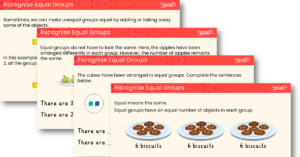
Recognise Equal Groups – Teaching PowerPoint
These lesson slides guide pupils through the prior learning of counting in 2s, 5s and 10s, before moving on to the main skill of recognising equal groups. There are a number of questions to check pupils' understanding throughout.
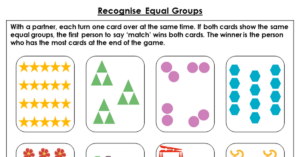
Recognise Equal Groups – Discussion Problem
This worksheet includes one discussion problem that can be used in pairs or in small groups to enable pupils to further their understanding of the concepts linked to recognising equal groups.
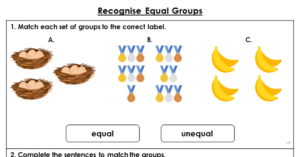
Recognise Equal Groups – Extension
This worksheet includes a range of varied fluency and reasoning and problem solving questions for pupils to further extend and practise the main skill of recognising equal groups.

Recognise Equal Groups – Reasoning and Problem Solving
This worksheet includes a range of reasoning and problem solving questions for pupils to practise the main skill of recognising equal groups.
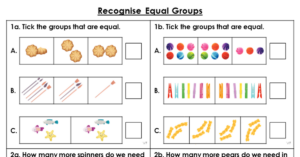
Recognise Equal Groups – Varied Fluency
This worksheet includes a range of varied fluency questions for pupils to practise the main skill of recognising equal groups.
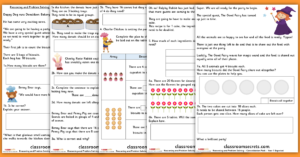
Multiplication and Division Consolidation Year 1 Summer Block 1 Reasoning and Problem Solving
This Multiplication and Division Consolidation Year 1 resource will help your pupils consolidate their understanding of Summer Block 1: Multiplication and Division. This resource is themed around preparing for a party for the good fairy.

Year 1 Count in 2s Lesson
This Year 1 Count in 2s lesson includes teaching slides, prior learning, worksheets, interactive activities and extensions.

Year 1 Count in 5s Lesson
This Year 1 Count in 5s lesson includes teaching slides, prior learning, worksheets, interactive activities and extensions.
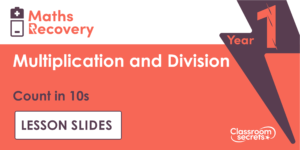
Free Year 1 Count in 10s Lesson Slides
These interactive Year 1 Count in 10s Lesson Slides are designed to support your teaching of this objective.

Free Year 1 Count in 10s Lesson
This Year 1 Count in 10s Lesson includes teaching slides, prior learning, worksheets, interactive activities and extensions.
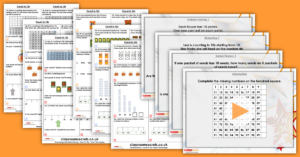
Count in 10s Year 1 Multiplication Free Resource Pack
Step 1: This Year 1 Count in 10s lesson pack includes a teaching PowerPoint and differentiated varied fluency, and reasoning problem solving questions Summer 1 Block 1 Number: Multiplication and Division.

Free Count in 10s Homework Extension Year 1 Multiplication and Division
Step 1: Free Count in 10s Homework Extension provides additional questions which can be used as homework or an in-class extension for the Year 1 Count in 10s Resource Pack and are differentiated three ways.
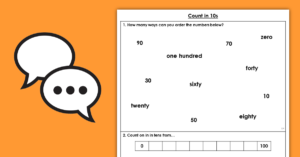
Multiplication and Division Year 1 Count in 10s Free Discussion Problems
Step 1: Year 1 Count in 10s Discussion Problems includes two discussion problems which can be used in pairs or small groups to further pupils' understanding.

Year 1 Making Equal Groups Lesson Slides
These interactive Year 1 Making Equal Groups Lesson Slides are designed to support your teaching of this objective.

Year 1 Making Equal Groups Lesson
This Year 1 Making Equal Groups Lesson includes teaching slides, prior learning, worksheets, interactive activities and extensions.
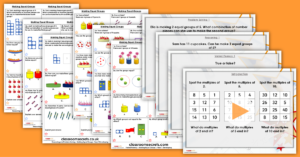
Making Equal Groups Year 1 Multiplication and Division Resource Pack
Step 2: This Making Equal Groups Year 1 lesson pack includes a teaching PowerPoint, plus differentiated varied fluency and reasoning problem solving questions.
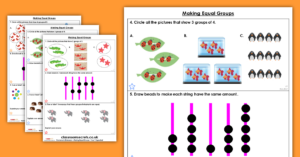
Making Equal Groups Homework Extension Year 1 Multiplication and Division
Step 2: Making Equal Groups Homework Extension provides additional questions which can be used as homework or an in-class extension for the Year 1 Making Equal Groups Resource Pack and are differentiated three ways.

Multiplication and Division Year 1 Making Equal Groups Discussion Problems
Step 2: Year 1 Making Equal Groups Discussion Problems includes two discussion problems which can be used in pairs or small groups to further pupils' understanding.

Year 1 Add Equal Groups Lesson Slides
These interactive Year 1 Add Equal Groups Lesson Slides are designed to support your teaching of this objective.

Year 1 Add Equal Groups Lesson
This Year 1 Add Equal Groups Lesson includes teaching slides, prior learning, worksheets, interactive activities and extensions.

Add Equal Groups Year 1 Multiplication and Division Resource Pack
Step 3: This Add Equal Groups Year 1 Multiplication and Division Resource Pack includes a teaching PowerPoint and differentiated varied fluency and reasoning and problem solving resources for Summer Block 1.
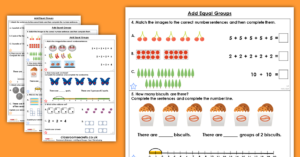
Add Equal Groups Homework Extension Year 1 Multiplication and Division
Step 3: Add Equal Groups Homework Extension provides additional questions which can be used as homework or an in-class extension for the Year 1 Add Equal Groups Resource Pack and are differentiated three ways.

Multiplication and Division Year 1 Add Equal Groups Discussion Problems
Step 3: Year 1 Add Equal Groups Discussion Problems includes two discussion problems which can be used in pairs or small groups to further pupils' understanding.

Year 1 Make Arrays Lesson Slides
These interactive Year 1 Make Arrays Lesson Slides are designed to support your teaching of this objective.
Stay in touch
01422 419608
[email protected]
Interested in getting weekly updates from us? Then sign up to our newsletter here!

Information

- Cookie Policy
- Privacy Policy
- Terms and Conditions
Copyright: Classroom Secrets 2024
Company number: 8401067
VAT number: 248 8245 74
- Terms & Conditions
Designed by Classroom Secrets
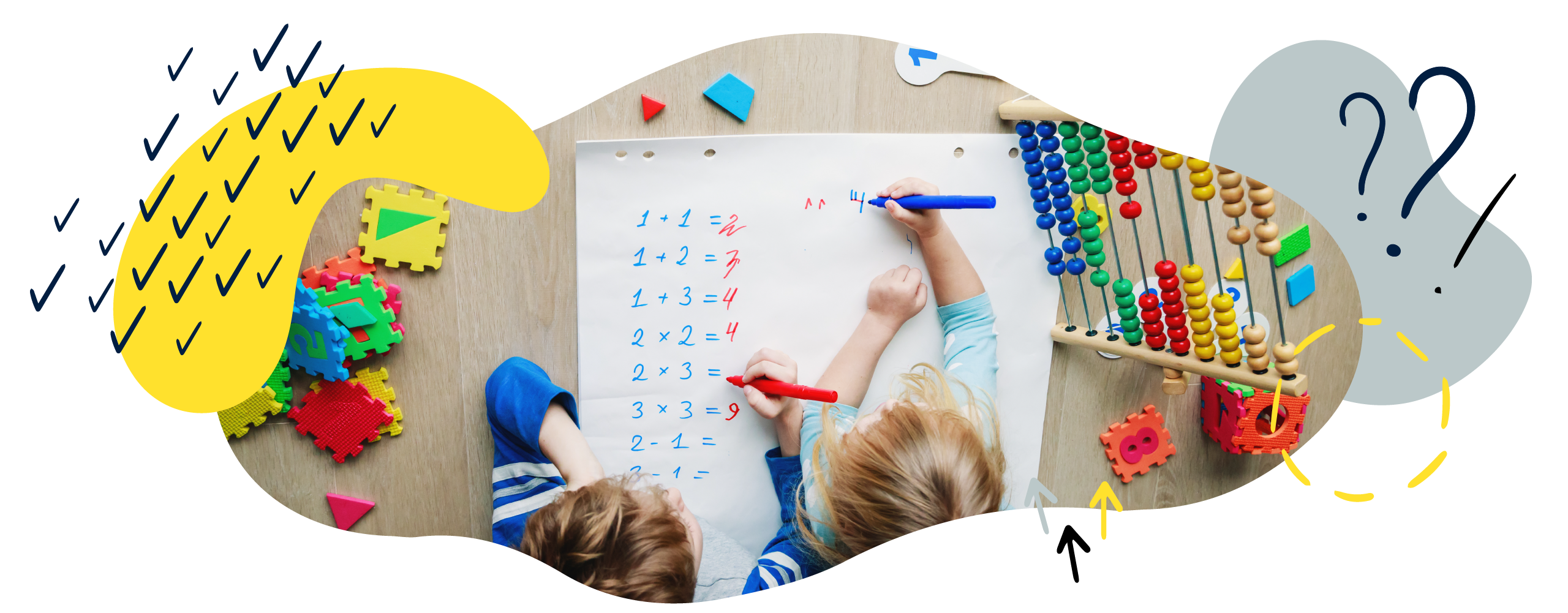
Child Login
- Kindergarten
- Number charts
- Skip Counting
- Place Value
- Number Lines
- Subtraction
- Multiplication
- Word Problems
- Comparing Numbers
- Ordering Numbers
- Odd and Even
- Prime and Composite
- Roman Numerals
- Ordinal Numbers
- In and Out Boxes
- Number System Conversions
- More Number Sense Worksheets
- Size Comparison
- Measuring Length
- Metric Unit Conversion
- Customary Unit Conversion
- Temperature
- More Measurement Worksheets
- Writing Checks
- Profit and Loss
- Simple Interest
- Compound Interest
- Tally Marks
- Mean, Median, Mode, Range
- Mean Absolute Deviation
- Stem-and-leaf Plot
- Box-and-whisker Plot
- Permutation and Combination
- Probability
- Venn Diagram
- More Statistics Worksheets
- Shapes - 2D
- Shapes - 3D
- Lines, Rays and Line Segments
- Points, Lines and Planes
- Transformation
- Quadrilateral
- Ordered Pairs
- Midpoint Formula
- Distance Formula
- Parallel, Perpendicular and Intersecting Lines
- Scale Factor
- Surface Area
- Pythagorean Theorem
- More Geometry Worksheets
- Converting between Fractions and Decimals
- Significant Figures
- Convert between Fractions, Decimals, and Percents
- Proportions
- Direct and Inverse Variation
- Order of Operations
- Squaring Numbers
- Square Roots
- Scientific Notations
- Speed, Distance, and Time
- Absolute Value
- More Pre-Algebra Worksheets
- Translating Algebraic Phrases
- Evaluating Algebraic Expressions
- Simplifying Algebraic Expressions
- Algebraic Identities
- Quadratic Equations
- Systems of Equations
- Polynomials
- Inequalities
- Sequence and Series
- Complex Numbers
- More Algebra Worksheets
- Trigonometry
- Math Workbooks
- English Language Arts
- Summer Review Packets
- Social Studies
- Holidays and Events
- Worksheets >
- Number Sense >
- Division >
Division Word Problem Worksheets
This page contains extensive division word problems replete with engaging scenarios that involve two-digit and three-digit dividends and single digit divisors; three-digit dividends and two-digit divisors; and advanced division worksheets (four-digit and five-digit dividends). Thumb through some of these worksheets for free!

Division Word Problems for Beginners
These printable worksheets feature simple division word problems. The divisors are in the range 2 to 9. The quotients are in the range 2 to 10. These worksheets are building blocks for children.
- Download the set
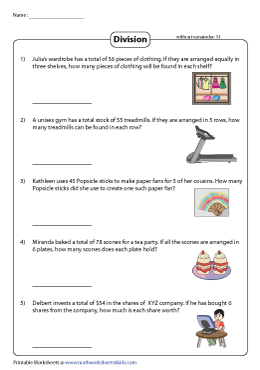
Division: Two-digit by Single-digit (without Remainder)
This set of word problems involves dividing a two-digit number by a single-digit number to arrive at a quotient. The division leaves no remainder. Answer key is included in each worksheet.
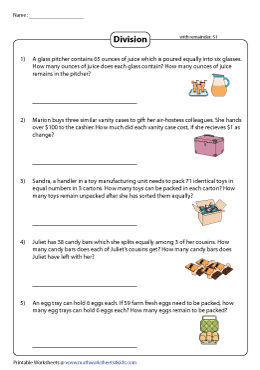
Division: Two-digit by Single-digit (with Remainder)
These word problems require the learner to divide the two-digit dividend by the single-digit divisor and write down both the quotient and the remainder. Three pdf worksheets with 15 scenarios are featured here.
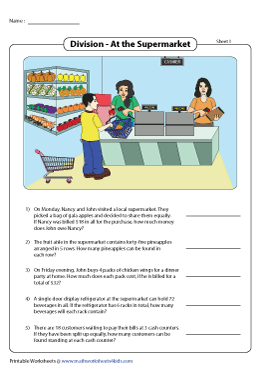
Theme based Word Problems
Each worksheet has five word problems related to the given theme. Supermarket, School and Halloween party are the themes used here.
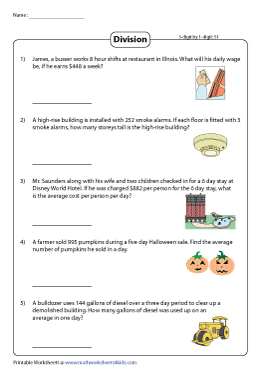
Three-digit by Single-digit Word Problems
These printable worksheets involve division word problems with three-digit dividends and single digit divisors. Apply long division method to solve each problem.
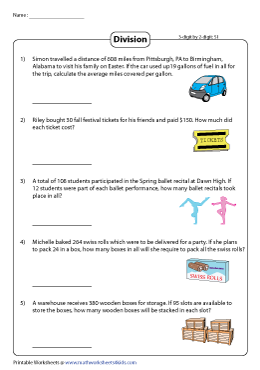
Three-digit by Two-digit Word Problems
This set of word problems will require the student to perform division operations involving three-digit numbers and two-digit numbers. Verify your answer with the answer key provided in the worksheet.
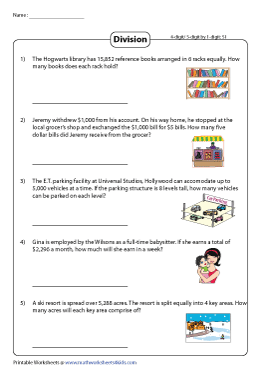
Division: Four or Five-digit by Single-digit
Interesting scenarios are presented in these advanced worksheet pdfs that involve four-digit and five-digit dividends and single digit divisors. Use long division method to find the quotient.
Related Worksheets
» Addition Word Problems
» Subtraction Word Problems
» Multiplication Word Problems
» Word Problems
Become a Member
Membership Information
Privacy Policy
What's New?
Printing Help
Testimonial
Copyright © 2024 - Math Worksheets 4 Kids
This is a members-only feature!

Free Printable Division Word Problems Worksheets for 1st Year
Math Division Word Problems: Discover a collection of free printable worksheets tailored for Year 1 students to enhance their understanding of division concepts through engaging word problems.

Explore Division Word Problems Worksheets by Grades
- kindergarten

Explore Other Subject Worksheets for year 1
- Social studies
- Social emotional
- Foreign language
- Reading & Writing
Explore printable Division Word Problems worksheets for 1st Year
Division Word Problems worksheets for Year 1 are an essential tool for teachers looking to help their students build a strong foundation in math. These worksheets provide a variety of math word problems that are specifically designed for first graders, ensuring that the content is age-appropriate and engaging. By incorporating real-life scenarios and relatable situations, these worksheets make learning division fun and accessible for young learners. Teachers can use these worksheets as a supplement to their existing math curriculum, or as a standalone resource for extra practice and reinforcement. With a wide range of problems and difficulty levels, Division Word Problems worksheets for Year 1 cater to the diverse needs of students and help them develop critical thinking and problem-solving skills in math.
In addition to Division Word Problems worksheets for Year 1, Quizizz offers a comprehensive platform for teachers to create interactive quizzes and assessments that can be easily integrated into their lesson plans. With Quizizz, teachers can access a vast library of pre-made quizzes covering various topics in math, including math word problems. The platform also allows teachers to customize quizzes to meet the specific needs of their students, ensuring that the content is aligned with their grade level and learning objectives. Furthermore, Quizizz provides real-time feedback and analytics, enabling teachers to monitor student progress and identify areas for improvement. By combining the use of Division Word Problems worksheets for Year 1 with the interactive features of Quizizz, teachers can create a dynamic and engaging learning environment that fosters a deep understanding of math concepts and skills.
Classroom Stars

Year 1 | Division Word Problems Worksheets
In these Year 1 division word problems worksheets , your pupils are set for a journey into real-world scenarios! Picture this: a boy sharing crayons with his friends, and your class gets to dive into the exciting challenge of figuring out how many crayons each friend will receive in this sharing scenario. They’ll also venture into the world of apples, dividing them into groups and expressing it all through division sentences.
These Year 1 division word problems worksheets bridge the gap between division and real-life situations, helping children see the practical applications of division in everyday scenarios. Finding the answer to division word problems through sentences not only reinforces maths skills but also supports children’s language development, encouraging clear communication of mathematical ideas.
Our Year 1 division word problems worksheets are aligned with KS1 multiplication and division on the primary national curriculum. All of our Year 1 division worksheets can be used with your ideas for primary maths activities, learning resources, teaching material, visual aids, games, differentiation, display boards, homework, and lesson plans.
You may want to check out our Year 1 Lots of (Multiplication) Worksheets .
Explore the rest of our Year 1 maths worksheets .
Access this resource and thousands more for just £9.95 per year
You might also like...

Counting in 8s Flashcards

Year 2 | Reading Numbers to 100 Worksheets

Year 1 | Counting in 5s Worksheets
You have subscribed to our newsletter.
You have joined the list to receive our newsletter! Be sure to look out for all our latest resources, news and reads from our blog.
New password created
Your new password has been created. A confirmation email has been sent to you.
Check your email
We have sent you an email with a link to create a new password.
Remember to check the junk folder in case the link was sent there.
Your message has been received
Thank you for getting in contact with us! A member of our team will do their best to get back to you as soon as possible.
Request for school membership received
Thank you for providing us with your details. A member of our team will get back to you as soon as possible with the next steps.
Email address updated
Your email address has been updated. A confirmation has been sent to your previous email address.
Download your free resource pack
Thank you for joining the list to receive our newsletter! Click below to download your free sample resource pack.
Username or Email
Remember Me
Lost Password?
- International
- Schools directory
- Resources Jobs Schools directory News Search
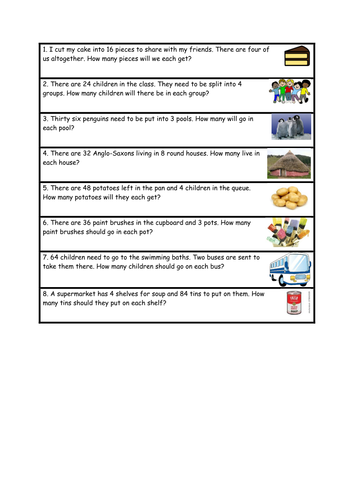
Division word problems- differentiated
Subject: Mathematics
Age range: 7-11
Resource type: Worksheet/Activity
Last updated
6 August 2020
- Share through email
- Share through twitter
- Share through linkedin
- Share through facebook
- Share through pinterest

Creative Commons "Sharealike"
Your rating is required to reflect your happiness.
It's good to leave some feedback.
Something went wrong, please try again later.
matt_roberts
Thanks for these, really useful.
Empty reply does not make any sense for the end user
felicia_ellis
Great document. I edited the second page to create questions for my higher ability.
Very useful Thanks.
greg_pickering1
Report this resource to let us know if it violates our terms and conditions. Our customer service team will review your report and will be in touch.
Not quite what you were looking for? Search by keyword to find the right resource:
If you're seeing this message, it means we're having trouble loading external resources on our website.
If you're behind a web filter, please make sure that the domains *.kastatic.org and *.kasandbox.org are unblocked.
To log in and use all the features of Khan Academy, please enable JavaScript in your browser.
Unit 5: Division
About this unit.
Do you like breaking things apart? Then you're going to love learning about division! We'll use place value, area models, and estimation techniques to make dividing by 1-digit numbers a breeze. In this unit, you will even get the inside scoop on what to do when there's a pesky remainder left over.
- Division: FAQ (Opens a modal)
- Estimating division that results in non-whole numbers (Opens a modal)
- Understanding remainders (Opens a modal)
- Introduction to remainders (Opens a modal)
- Interpreting remainders (Opens a modal)
- Estimate to divide by 1-digit numbers Get 3 of 4 questions to level up!
- Interpret remainders Get 3 of 4 questions to level up!
- Divide with remainders (2-digit by 1-digit) Get 3 of 4 questions to level up!
Divide multiples of 10, 100, and 1,000 by 1-digit numbers
- Quotients that are multiples of 10 (Opens a modal)
- Divide multiples of 10, 100, and 1,000 by 1-digit numbers Get 5 of 7 questions to level up!
Division with place value
- Division using place value (Opens a modal)
- Divide using place value Get 3 of 4 questions to level up!
Division with area models
- Division with area models (Opens a modal)
- Create division equations with area models Get 3 of 4 questions to level up!
- Divide by 1-digit numbers with area models Get 3 of 4 questions to level up!
Estimate quotients
- Estimating quotients (Opens a modal)
- Estimate quotients (3- and 4-digit divided by 1-digit) Get 3 of 4 questions to level up!
Multi-digit division with partial quotients
- Introduction to division with partial quotients (no remainder) (Opens a modal)
- Division with partial quotients (remainder) (Opens a modal)
- Intro to long division (no remainders) (Opens a modal)
- Divide multi-digit numbers by 2, 3, 4, and 5 (remainders) Get 5 of 7 questions to level up!
- Divide multi-digit numbers by 6, 7, 8, and 9 (remainders) Get 3 of 4 questions to level up!
Multiplication, division word problems
- Division word problem: field goals (Opens a modal)
- Multiplication word problem: pizza (Opens a modal)
- Multiplication and division word problems Get 5 of 7 questions to level up!
Multi-step word problems
- 2-step estimation word problem (Opens a modal)
- 2-step estimation word problems Get 3 of 4 questions to level up!
- Represent multi-step word problems using equations Get 3 of 4 questions to level up!
- Multi-step word problems with whole numbers Get 3 of 4 questions to level up!
Word Problems on Division
Word problems on division for fourth grade students are solved here step by step.
Consider the following examples on word problems involving division: 1. $5,876 are distributed equally among 26 men. How much money will each person get? Solution: Money received by 26 men = 5876 So, money received by one man = 5876 ÷ 26 = 226
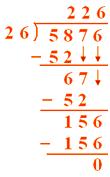
Each man will get $226.
2. If 9975 kg of wheat is packed in 95 bags, how much wheat will each bag contain?
Since 95 bags contain wheat 9975 kg Therefore, 1 bag contains wheat (9975 ÷ 95) kg = 105 kg
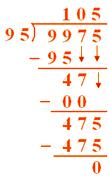
Each bag contains wheat = 105 kg In a problem sum involving division, we have to be careful about using the remainder.
3. 89 people have been invited to a banquet. The caterer is arranging tables. Each table can seat 12 people. How many tables are needed? Solution: To answer this question, we need to divide 89 by 12 89 ÷ 12

Quotient - 7
Remainder - 5
If the caterer arranges 7 tables, then 5 people will have no place to sit. So he needs to arrange 7 + 1 = 8 tables.
4. How many hours are there in 1200 minutes?
Solution: We know that there are 60 minutes in 1 hour.Divide the number of minutes by the number of minutes in 1 hour. We get, divide 1200 by 601200 ÷ 60 = 20
So there are 20 hours in 1200 minutes.
Answer: 20 hours.
5. A bus can hold 108 passengers. If there are 12 rows of seats on the bus, how many seats are in each row?
Solution: Total number of passengers = 108
There are 12 rows of seats on the bus.
To find how many seats are there in each row, divide the total number of passengers by the number of rows of seats on the bus.
We get, divide 108 by 12
108 ÷ 12 = 9
Therefore, there are 9 seats in each row.
Answer: 9 seats.
6. Tom had 63 apples. He divides all apples evenly among 9 friends. How many apples did Tom give to each of his friends?
Solution: Total number of apples = 63
There are 9 friends of seats on the bus.
To find how many apples Tom gave to each of his friends, divide the total number of apples by the number of friends.
We get, divide 63 by 9
Therefore, Tom gives 7 apples to each of his friends.
Answer: 7 Apples
7. Mark baked 195 cookies and divided them equally into 13 packs. How many cookies did Mark put in each packet?
Solution: Total number of cookies = 195
There are 13 packs.
To find how many cookies did Mark put in each packet, divide the total number of cookies by the number of packs.
We get, divide 195 by 13
195 ÷ 13 = 15
Therefore, Mark put 15 cookies in each pack.
Answer: 15 cookies.
9. Nancy needs 5 lemons to make a glass of orange juice. If Nancy has 250 oranges, how many glasses of orange juice can she make?
Solution: Total number of oranges = 250
She needs 5 lemons to make a glass of orange juice.
To find how many glasses of orange juice can Nancy make, divide the total number of oranges by the number of oranges needed for each glass of orange juice.
We get, divide 250 by 5
250 ÷ 5 = 50
Therefore, Nancy can make 50 glasses of orange juice.
Answer: 50 glasses of orange juice.
10. In your classes you counted 120 hands. How many students were at the class?
Solution: Total number of hands = 120
We have 2 hands.
To find how many students were at the class, divide the total number of hands by the number of hands we have.
We get, divide 120 by 2
220 ÷ 2 = 60
Therefore, there were 60 students at the class.
Answer: 60 students.
11. The total train fare for 20 persons is 7540 rupees. What is the fare for 1 person.
12. A milk container can store 8 litres of milk. How many containers are required to stare 6,408 litres of milk?
Capacity of one container = 8 lites of milk
Required number of containers = 6408 ÷ 8
Hence, 801 containers are required.
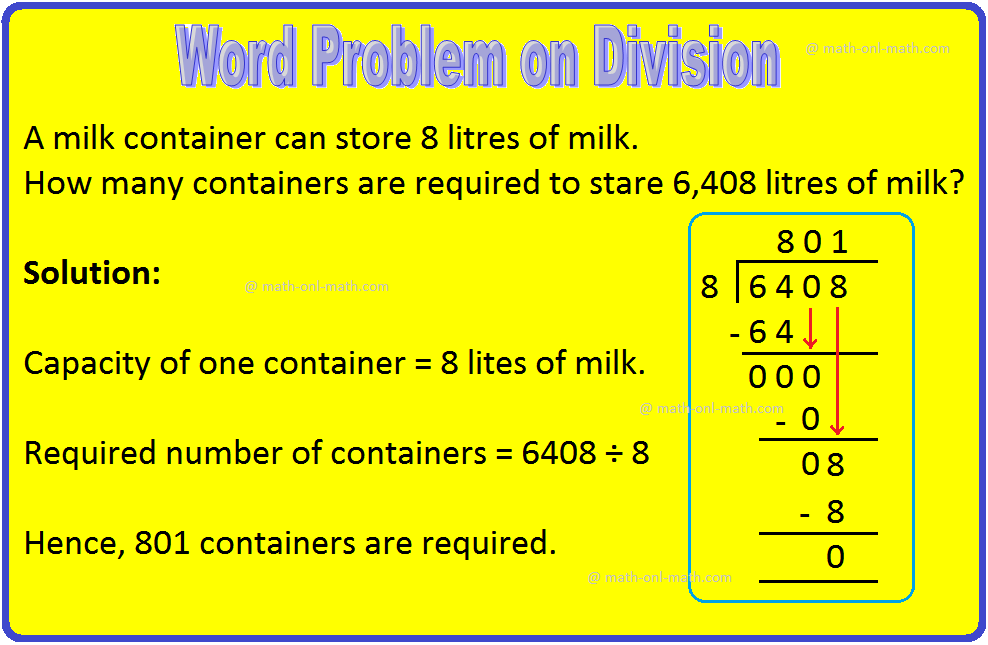
13. A farmer produced 29800 kg of wheat. How many bags will be buy store the wheat if one bag can hold 70 kg?
Produced = 29890 kg
Number of bags needed = 29899 ÷ 70
Therefore, 427 bags are needed to hold 29890 kg of wheat.
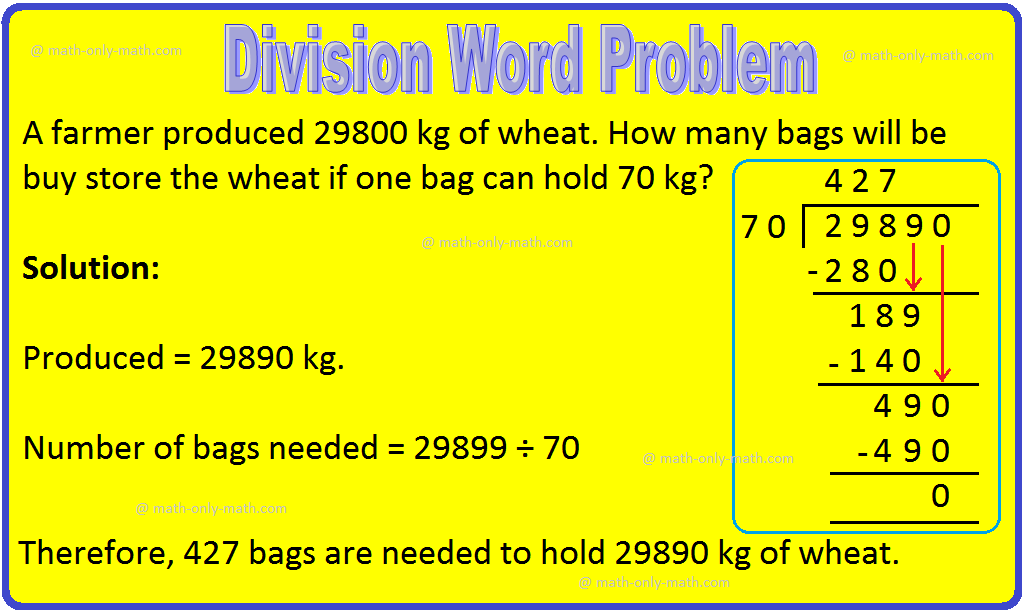
These are the basic word problems on division.
Questions and Answers on Word Problems on Division:
1. 92 bags of cement can be loaded in a truck. How many such trucks will be needed to load 2208 bags?
Answer: 24 trucks
2. The total train fare for 11 persons was $3850. What was the fare for one person?
Answer: $350
You might like these
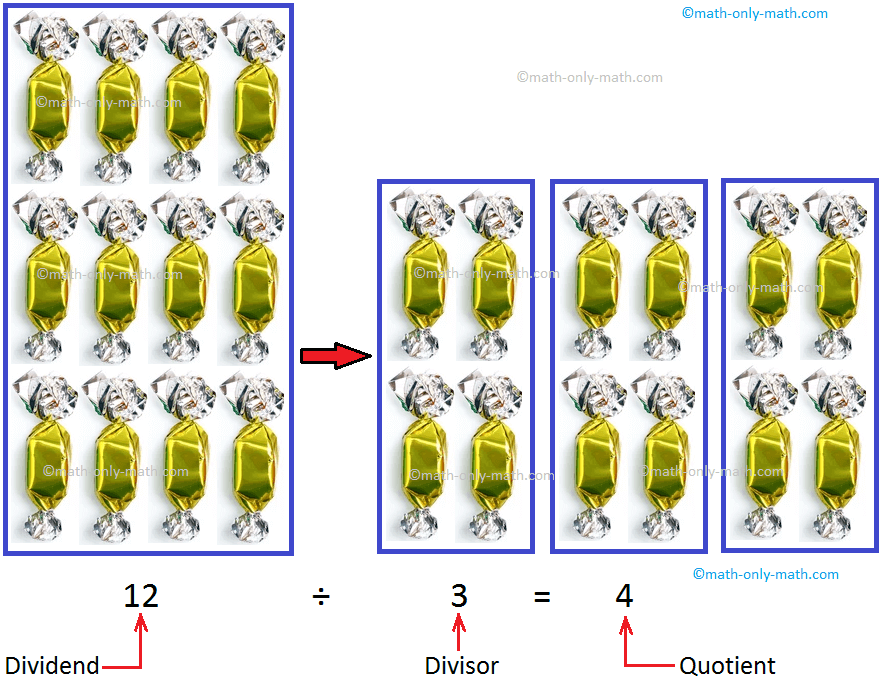
Terms Used in Division | Dividend | Divisor | Quotient | Remainder
The terms used in division are dividend, divisor, quotient and remainder. Division is repeated subtraction. For example: 24 ÷ 6 How many times would you subtract 6 from 24 to reach 0?
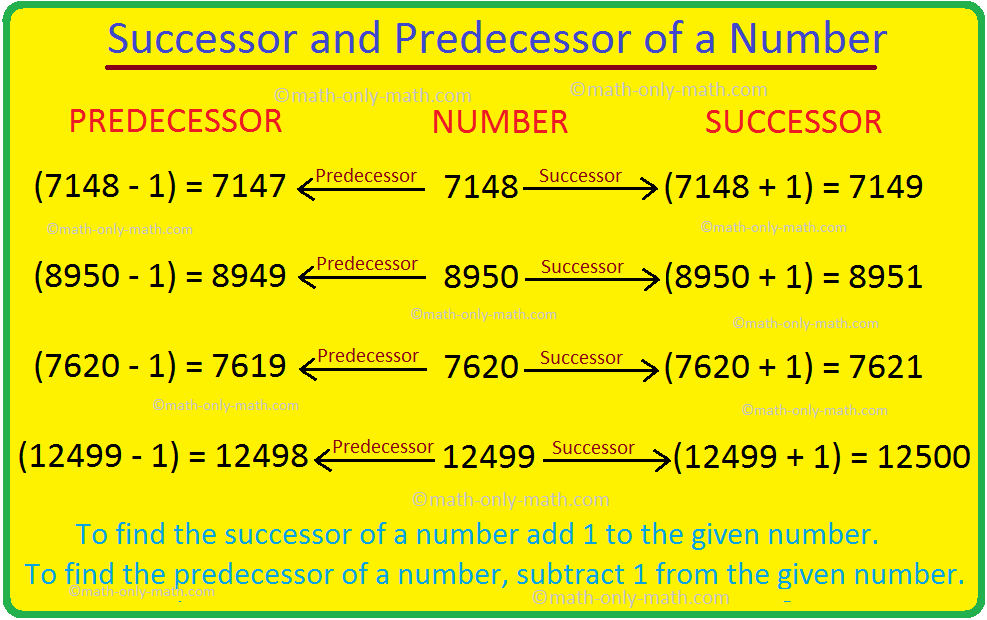
Successor and Predecessor | Successor of a Whole Number | Predecessor
The number that comes just before a number is called the predecessor. So, the predecessor of a given number is 1 less than the given number. Successor of a given number is 1 more than the given number. For example, 9,99,99,999 is predecessor of 10,00,00,000 or we can also

Number Worksheets | Practice Different Questions on Numbers | Answers
In number worksheets, students can practice different questions on numbers from printable free worksheets for grade 4 math on numbers. Write the number which is 1 more than 9? Write the number which
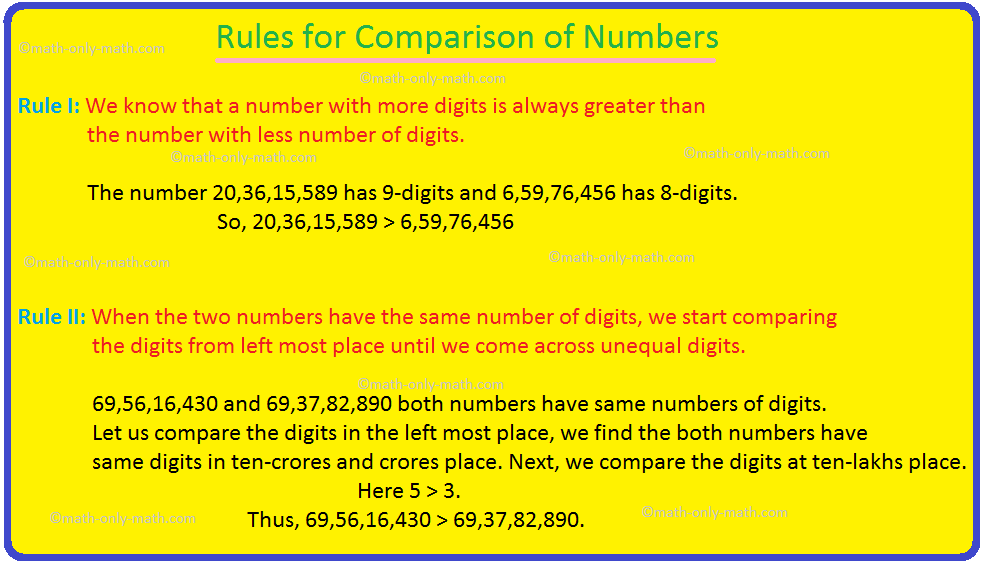
Comparison of Numbers | Compare Numbers Rules | Examples of Comparison
Rule I: We know that a number with more digits is always greater than the number with less number of digits. Rule II: When the two numbers have the same number of digits, we start comparing the digits from left most place until we come across unequal digits. To learn

Formation of Numbers | Smallest and Greatest Number| Number Formation
In formation of numbers we will learn the numbers having different numbers of digits. We know that: (i) Greatest number of one digit = 9,
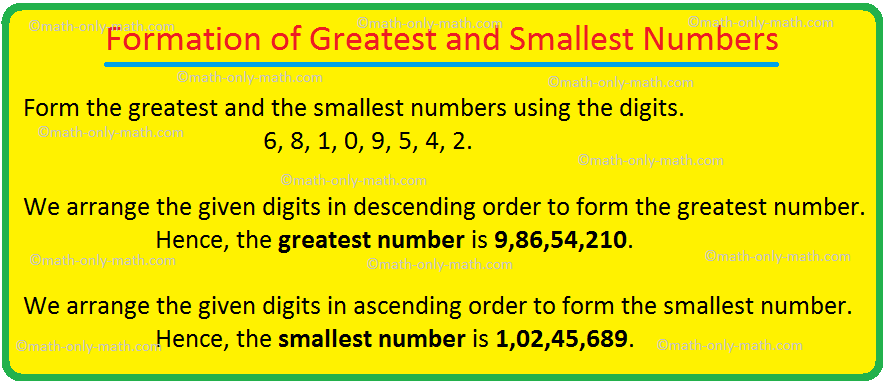
Formation of Greatest and Smallest Numbers | Arranging the Numbers
the greatest number is formed by arranging the given digits in descending order and the smallest number by arranging them in ascending order. The position of the digit at the extreme left of a number increases its place value. So the greatest digit should be placed at the
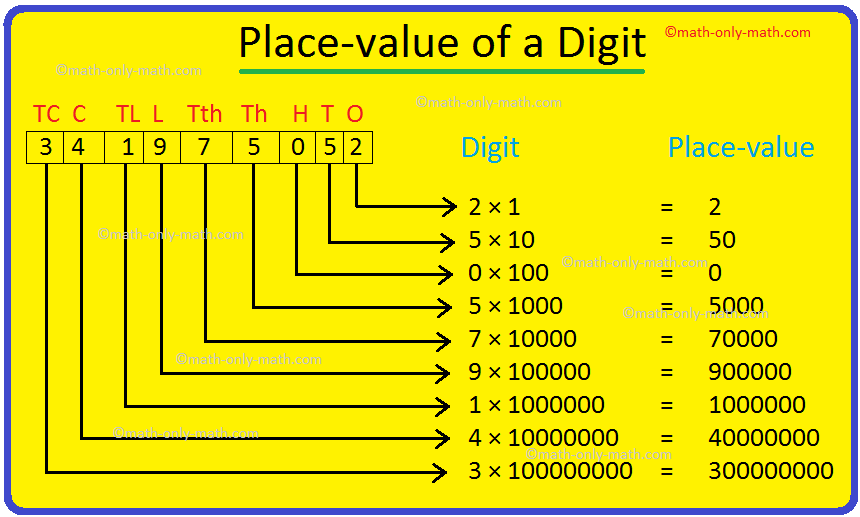
Place Value | Place, Place Value and Face Value | Grouping the Digits
The place value of a digit in a number is the value it holds to be at the place in the number. We know about the place value and face value of a digit and we will learn about it in details. We know that the position of a digit in a number determines its corresponding value
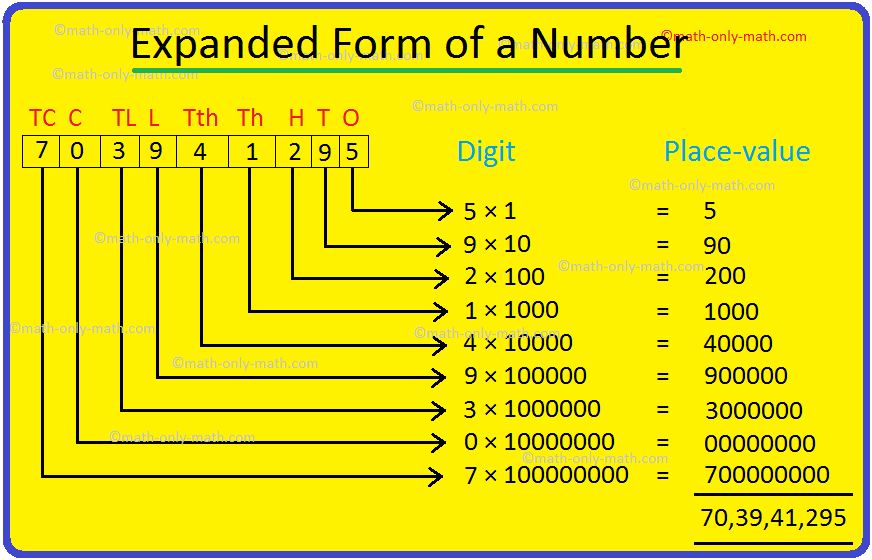
Expanded Form of a Number | Writing Numbers in Expanded Form | Values
We know that the number written as sum of the place-values of its digits is called the expanded form of a number. In expanded form of a number, the number is shown according to the place values of its digits. This is shown here: In 2385, the place values of the digits are
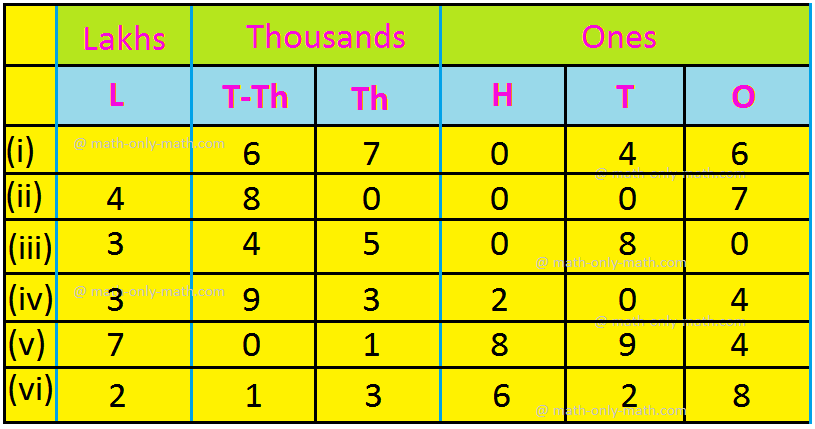
Worksheet on Place Value | Place Value of a Digit in a Number | Math
Worksheet on place value for fourth grade math questions to practice the place value of a digit in a number. 1. Find the place value of 7 in the following numbers: (i) 7531 (ii) 5731 (iii) 5371

Worksheet on Expanded form of a Number | Expanded Form of a Number
Worksheet on expanded form of a number for fourth grade math questions to practice the expanded form according to the place values of its digit. 1. Write the expanded form of the following numbers

Examples on the Formation of Greatest and the Smallest Number |Example
In examples on the formation of greatest and the smallest number we know that the procedure of arranging the numbers in ascending and descending order.

Worksheet on Formation of Numbers | Questions on Formation of Numbers
In worksheet on formation of numbers, four grade students can practice the questions on formation of numbers without the repetition of the given digits. This sheet can be practiced by students
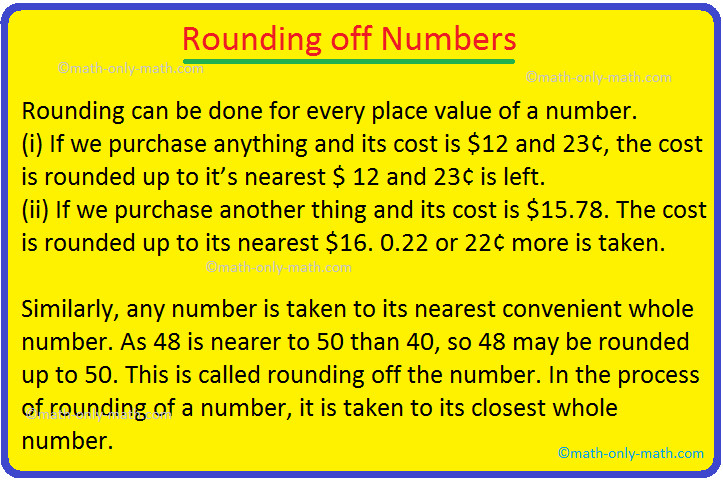
Rounding off Numbers | Nearest Multiple of 10 | Nearest Whole Number
Rounding off numbers are discussed here, where we need to round a number. (i) If we purchase anything and its cost is $12 and 23¢, the cost is rounded up to it’s nearest $ 12 and 23¢ is left. (ii) If we purchase another thing and its cost is $15.78. The cost is rounded up

Properties of Multiples | With Examples | Multiple of each Factor
The properties of multiples are discussed step by step according to its property. Every number is a multiple of 1. Every number is the multiple of itself. Zero (0) is a multiple of every number. Every multiple except zero is either equal to or greater than any of its factors
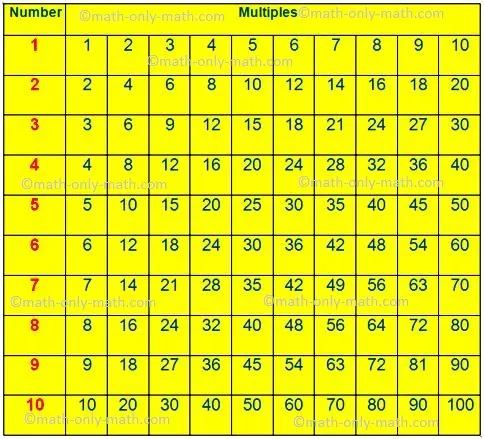
Multiples | Multiples of a Number |Common Multiple|First Ten Multiples
What are multiples? ‘The product obtained on multiplying two or more whole numbers is called a multiple of that number or the numbers being multiplied.’ We know that when two numbers are multiplied the result is called the product or the multiple of given numbers.
Related Concept
● Word Problems on Addition
● Subtraction
● Check for Subtraction and Addition
● Word Problems Involving Addition and Subtraction
● Estimating Sums and Differences
● Find the Missing Digits
● Multiplication
● Multiply a Number by a 2-Digit Number
● Multiplication of a Number by a 3-Digit Number
● Multiply a Number
● Estimating Products
● Word Problems on Multiplication
● Multiplication and Division
● Terms Used in Division
● Division of Two-Digit by a One-Digit Numbers
● Division of Four-Digit by a One-Digit Numbers
● Division by 10 and 100 and 1000
● Dividing Numbers
● Estimating the Quotient
● Division by Two-Digit Numbers
● Word Problems on Division
4th Grade Math Activities From Word Problems on Division to HOME PAGE
Didn't find what you were looking for? Or want to know more information about Math Only Math . Use this Google Search to find what you need.
- Preschool Activities
- Kindergarten Math
- 1st Grade Math
- 2nd Grade Math
- 3rd Grade Math
- 4th Grade Math
- 5th Grade Math
- 6th Grade Math
- 7th Grade Math
- 8th Grade Math
- 9th Grade Math
- 10th Grade Math
- 11 & 12 Grade Math
- Concepts of Sets
- Probability
- Boolean Algebra
- Math Coloring Pages
- Multiplication Table
- Cool Maths Games
- Math Flash Cards
- Online Math Quiz
- Math Puzzles
- Binary System
- Math Dictionary
- Conversion Chart
- Homework Sheets
- Math Problem Ans
- Free Math Answers
- Printable Math Sheet
- Funny Math Answers
- Employment Test
- Math Patterns
- Link Partners
- Privacy Policy

Recent Articles
Time Duration |How to Calculate the Time Duration (in Hours & Minutes)
Apr 16, 24 02:19 AM
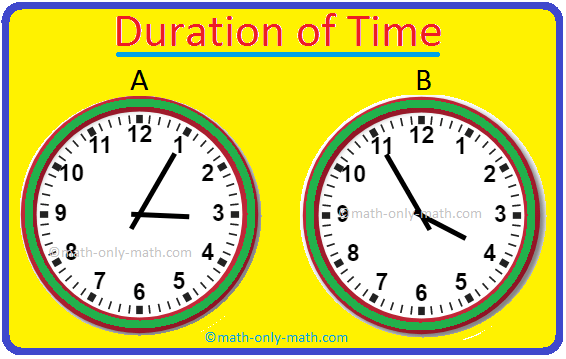
Worksheet on Third Grade Geometrical Shapes | Questions on Geometry
Apr 16, 24 02:00 AM
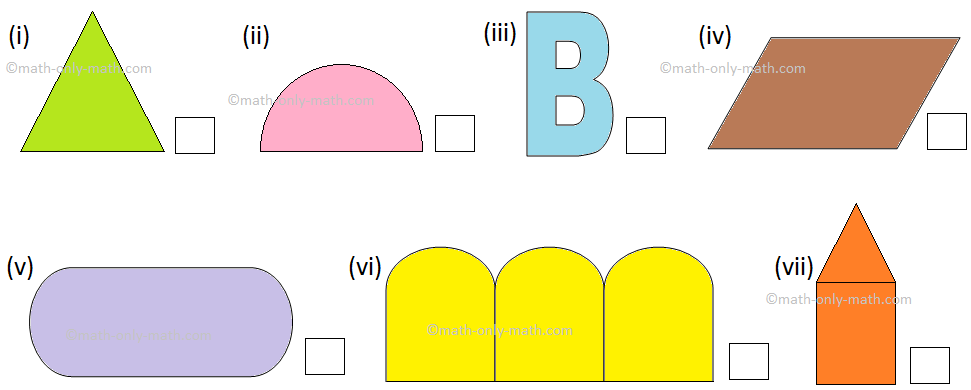
4th Grade Mental Math on Factors and Multiples |Worksheet with Answers
Apr 16, 24 01:15 AM
Worksheet on Factors and Multiples | Find the Missing Factors | Answer
Apr 15, 24 11:30 PM

Method of L.C.M. | Finding L.C.M. | Smallest Common Multiple | Common
Apr 15, 24 02:33 PM
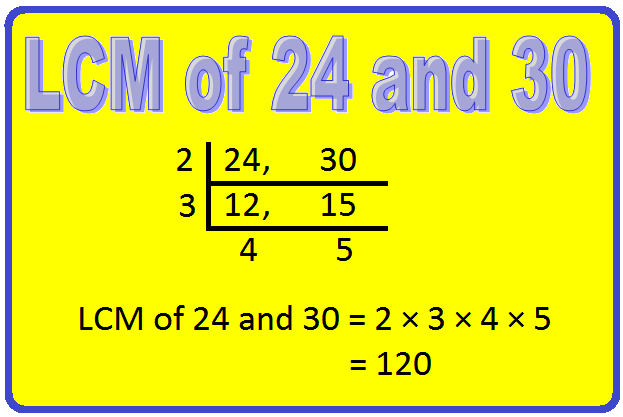
© and ™ math-only-math.com. All Rights Reserved. 2010 - 2024.

Division Practice Questions
Click here for questions, click here for answers, gcse revision cards.

5-a-day Workbooks

Primary Study Cards

Privacy Policy
Terms and Conditions
Corbettmaths © 2012 – 2024

Reading & Math for K-5
- Kindergarten
- Learning numbers
- Comparing numbers
- Place Value
- Roman numerals
- Subtraction
- Multiplication
- Order of operations
- Drills & practice
- Measurement
- Factoring & prime factors
- Proportions
- Shape & geometry
- Data & graphing
- Word problems
- Children's stories
- Leveled Stories
- Context clues
- Cause & effect
- Compare & contrast
- Fact vs. fiction
- Fact vs. opinion
- Main idea & details
- Story elements
- Conclusions & inferences
- Sounds & phonics
- Words & vocabulary
- Reading comprehension
- Early writing
- Numbers & counting
- Simple math
- Social skills
- Other activities
- Dolch sight words
- Fry sight words
- Multiple meaning words
- Prefixes & suffixes
- Vocabulary cards
- Other parts of speech
- Punctuation
- Capitalization
- Narrative writing
- Opinion writing
- Informative writing
- Cursive alphabet
- Cursive letters
- Cursive letter joins
- Cursive words
- Cursive sentences
- Cursive passages
- Grammar & Writing
Breadcrumbs
- Word Problems
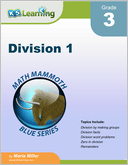
Download & Print Only $4.10
Division word problems for 3rd grade
Simple division word problems.
After reading the word problem and understanding the 'real world scenario', the student must formulate the division equation to solve the problem. Only simple division is required.

These worksheets are available to members only.
Join K5 to save time, skip ads and access more content. Learn More
More word problem worksheets
Explore all of our math word problem worksheets , from kindergarten through grade 5.
What is K5?
K5 Learning offers free worksheets , flashcards and inexpensive workbooks for kids in kindergarten to grade 5. Become a member to access additional content and skip ads.
Our members helped us give away millions of worksheets last year.
We provide free educational materials to parents and teachers in over 100 countries. If you can, please consider purchasing a membership ($24/year) to support our efforts.
Members skip ads and access exclusive features.
Learn about member benefits
This content is available to members only.
- Forgot Password?

IMAGES
VIDEO
COMMENTS
An award-winning maths scheme that has been written to address the aims of the 2014 curriculum and ready-to-progress criteria. Explore our FREE planning overviews by clicking here. Year 1 Number - Multiplication and Division Solve one-step problems involving multiplication and division, by calculating the answer using concrete objects ...
Ring a Ring of Numbers. Age 5 to 7. Challenge Level. Choose four of the numbers from 1 to 9 to put in the squares so that the differences between joined squares are odd.
Year 1 Number - Multiplication and Division Solve one-step problems involving multiplication and division, by calculating the answer using concrete objects, pictorial representations and arrays with the support of the teacher.
Missing factor problems (solve by long division) Mixed 4 operations word problems; Grade 6 division worksheets. 1-10,000 divided by 1-digit numbers, no remainder ... Our members helped us give away millions of worksheets last year. We provide free educational materials to parents and teachers in over 100 countries. If you can, please consider ...
Your child will be expected to solve simple division problems through sharing and grouping. For example: 10 ÷ 2 can be thought of as sharing 10 objects into 2 equal groups. ... Try different methods of division. In Year 1, your child will begin to understand division as sharing and grouping. There are many easy ways you can support this at home.
Differentiated maths resources for Summer Block 1 (Multiplication and Division) in small steps for KS1 children in Year 1. Each small step contains a pack of resources which includes a teaching PowerPoint, a varied fluency worksheet pack (in three differentiated levels) and a reasoning and problem solving worksheet pack (in 3 differentiated levels).
In Year 1, your child will be expected to be able to solve simple multiplication and division problems using objects, drawings, and arrays to help them. This includes: counting in steps of 2, 5, and 10 and understanding that, for example, 3 × 2 is the same as 2 + 2 + 2; sharing and grouping to solve division problems
Apply long division method to solve each problem. Download the set; Three-digit by Two-digit Word Problems. This set of word problems will require the student to perform division operations involving three-digit numbers and two-digit numbers. Verify your answer with the answer key provided in the worksheet. ... at only $24.95/year - about 7 ...
MATH 1 SOLVING WORD PROBLEMS MULTIPLICATION 12 Q. 1st Math Word Problems 17 Q. 1st - PD Word Problems 10 Q. 1st Division Word Problems 5 Q. 1st Word Problems ... Division Word Problems worksheets for Year 1 are an essential tool for teachers looking to help their students build a strong foundation in math. These worksheets provide a variety of ...
Our Year 1 division word problems worksheets are aligned with KS1 multiplication and division on the primary national curriculum. All of our Year 1 division worksheets can be used with your ideas for primary maths activities, learning resources, teaching material, visual aids, games, differentiation, display boards, homework, and lesson plans ...
Put the plates in a cross. Use all 15 counters. Put a different number on each plate. Make each line add up to 10. Do it again. This time make each line add up to 8. Solve mathematical problems or puzzles. Know addition and subtraction facts up to 10. Add three small numbers mentally.
Division word problems- differentiated. Subject: Mathematics. Age range: 7-11. Resource type: Worksheet/Activity. File previews. docx, 214.33 KB. 2 sheets of division word problems to be solved using the bus stop method. First sheet is 2 digit and second is 3 digits. Children cut out a question and stick into their books then answer underneath.
Interactive PDF: White Rose Maths Supporting Year 2: Spring Block 1 Multiplication and Division: Divide by 10. 5.0 (1 review) ... While completing the activities included in these activity sheets, children will practise solving basic division problems within the multiplication tables and write them using the division (÷) and equals (=) signs.
Unit test. Level up on all the skills in this unit and collect up to 1,400 Mastery points! Start Unit test. Do you like breaking things apart? Then you're going to love learning about division! We'll use place value, area models, and estimation techniques to make dividing by 1-digit numbers a breeze. In this unit, you will even get the inside ...
Consider the following examples on word problems involving division: 1. $5,876 are distributed equally among 26 men. How much money will each person get? Solution: Money received by 26 men = 5876 So, money received by one man = 5876 ÷ 26. = 226.
Click here for Answers. dividing. Practice Questions. Previous: Dimensional Analysis Practice Questions. Next: Multiply and Dividing by 10, 100, 1000 etc Practice Questions. The Corbettmaths Practice Questions on Division.
Mathematics Year 4: Recall multiplication and division facts for multiplication tables up to 12 X 12. More resources with this objective. Mathematics Year 5: Divide numbers up to 4 digits by a one-digit number using the formal written method of short division and interpret remainders appropriately for the context. More resources with this ...
Simple division word problems. After reading the word problem and understanding the 'real world scenario', the student must formulate the division equation to solve the problem. Only simple division is required. Worksheet #1 Worksheet #2 Worksheet #3 Worksheet #4. Worksheet #5 Worksheet #6.
Each example has two steps. Questions 3, 6 and 9 (Problem Solving) Developing Complete the number sentence with three given digits where the divisor is provided. The solution has one decimal place. Expected Choose the correct digits to complete the number sentence where the divisor is provided. The solution has two decimal places.